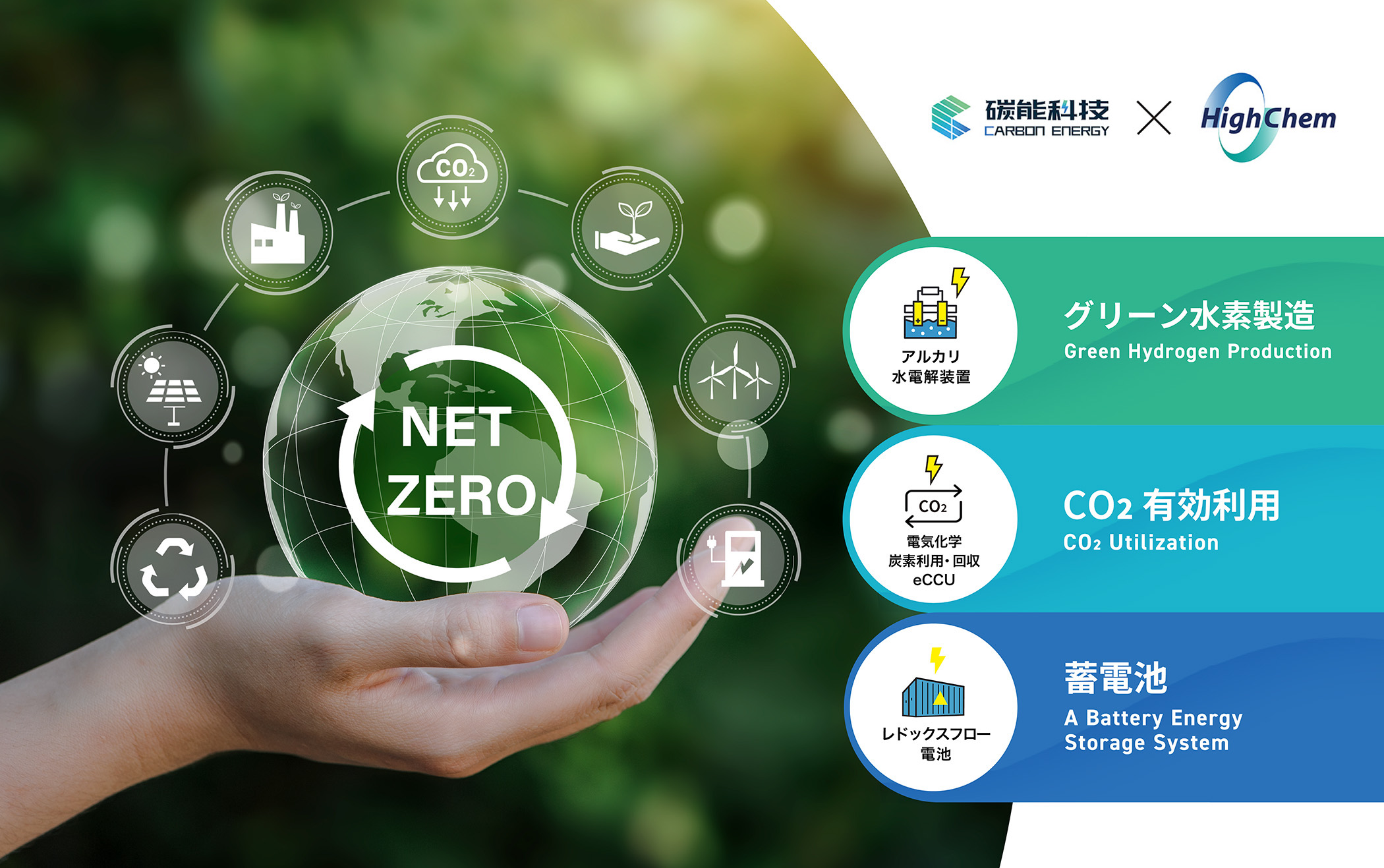
Joint Venture Established for CO2 Utilization Technology: Interview with Carbon Energy CEO Dr. Peng Kang
In today's report, we would like to share our interview with Dr. Peng Kang, founder and CEO of Carbon Energy, our new partner. Dr. Kang, who serves as a professor of Chemical Engineering at Tianjin University Graduate School, is one of China's prominent young researchers who has published numerous high-level papers in the field of electrochemical CO2 utilization. We asked him about Carbon Energy's advanced technologies that will realize future net-zero emissions and why they chose HighChem as their partner.
Carbon Energy Technology (Beijing) Co., Ltd. (Carbon Energy Company) CEO Kang Peng
profile
CEO, Carbon Energy Co., Ltd.
Professor, Graduate School of Chemical Engineering, Tianjin University
Born in 1982. After graduating from the University of Science and Technology of China's Department of Chemistry in 2004, he received his Ph.D. in Chemistry from Stanford University. From 2010, he worked as a postdoctoral researcher at the Solar Fuels Research Center, University of North Carolina at Chapel Hill, studying electrocatalytic methods for reducing CO2 to fuels and chemicals. In 2015, he established Carbon Energy (Beijing) Co., Ltd. in Beijing, China.

- Establishing Carbon Energy with the Goal of Founding the "Bell Labs" of New Energy
- HighChem and Carbon Energy collaborate to complete industrial chain for producing green Chemicals from CO2
- Steady Progress in Social Implementation of CO2 Electrolysis Syngas Production Technology in China
- The CO2 concentration in seawater is 130 times that of the atmosphere! Technology developed to capture CO2 from seawater and convert it into resources
- Global expansion of innovative technologies for carbon neutrality
Establishing Carbon Energy with the Goal of Founding the "Bell Labs" of New Energy

──First of all, please tell us about Carbon Energy.
"I established this R&D company in Beijing in 2015 with a strong desire to contribute to global carbon neutrality. As a professor at Tianjin University and a researcher involved in new energy R&D at the university, Carbon Energy serves as a platform for industrializing the new technologies we develop.
Our vision was to 'Found the Bell Labs of new energy to shape a sustainable future.' Bell Labs was an institution that promoted innovative R&D in the U.S. semiconductor field, creating and implementing numerous inventions that became the foundation of modern technology. We also want to create innovative technologies in the field of carbon neutrality and achieve their social implementation.
HighChem and Carbon Energy collaborate to complete industrial chain for producing green Chemicals from CO2

──Why did you establish the joint venture company "HighEnergy Co., Ltd." with HighChem?
Carbon Energy has developed a technology that electrolyzes CO2 and H2O to convert them into syngas and hydrogen. HighChem possesses C1 chemical technology to manufacture ethylene glycol using syngas and hydrogen, and has a proven track record of licensing this technology worldwide and implementing it in society. By combining the technologies of both companies, we can complete an industrial chain that manufactures green chemicals from CO2, which is the primary reason for this collaboration.
Beyond green chemical manufacturing, if we can produce syngas from CO2, it can be utilized as a raw material for downstream products such as green methanol and SAF, enabling a future where ship and aircraft fuels can be manufactured from CO2. Additionally, when ethylene glycol can be produced from CO2, we can achieve the greening of our clothes and PET bottles. These potential markets are extremely large, and we believe there is great significance in our endeavors.
Steady Progress in Social Implementation of CO2 Electrolysis Syngas Production Technology in China
 The world's first CO2 electrolysis synthesis gas production demonstration plant was completed in Inner Mongolia in 2020.
The world's first CO2 electrolysis synthesis gas production demonstration plant was completed in Inner Mongolia in 2020.
--Has the technology to electrolyze CO2 and convert it into synthetic gas already reached the industrial stage in China?
In 2020, the world's first demonstration plant for syngas production through CO2 electrolysis was completed at a coal chemical complex in Inner Mongolia. This plant has an annual production capacity of 30-50 tons and has already achieved over 4,000 hours of operation. In 2023, a demonstration plant with a scale of 100 tons/year was completed at China Energy Investment Corporation. In 2024, we are conducting industrial demonstration research for 500 tons/year CO2 electrolysis syngas production in collaboration with Yulin Energy Group Hengshan Coal Power Company, a major power company. We are currently advancing development aimed at establishing industrialization technology for syngas production from CO2 on a scale of tens of thousands of tons.
The CO2 concentration in seawater is 130 times that of the atmosphere! Technology developed to capture CO2 from seawater and convert it into resources

--- What is the technology that captures natural CO2 from seawater (eDOC)?
Traditionally, the CO2 used in the production of chemicals was typically captured from emissions from chemical plants and power plants. However, the amount of greenhouse gases we have emitted so far is so enormous that simply capturing these emissions is insufficient. When considering locations with high CO2 concentrations that can be recovered economically and efficiently from the perspective of overall greenhouse gas reduction and viewing CO2 as a resource, the answer was found in the "ocean." This is because greenhouse gases like CO2 are heavily absorbed by seawater, with CO2 concentrations in seawater being 130 times higher than in the atmosphere. Therefore, from a cost perspective, recovering CO2 from the ocean is far more advantageous.
Currently, Carbon Energy is developing electrochemical CO2 recovery technology from seawater. Furthermore, by adding alkaline substances to the seawater after recovery to restore its original weak alkaline state, the seawater can once again absorb CO2 from the atmosphere. In other words, by continuously implementing this process, atmospheric CO2 gradually decreases, ultimately achieving carbon neutrality.
What stage are these technological developments at?
This year, a demonstration facility using eDOC with a capacity of 10 tons per year is scheduled to be launched in a coastal area. Based on the data collected there, we plan to launch a pilot with a capacity of tens of thousands of tons per year.
--You are also expanding the scope of your research and development to include hydrogen production and redox flow batteries.
Yes, we believe that our CO2 electrolysis technology can contribute to various technologies aimed at achieving carbon neutrality. We are currently focusing on selected fields, and some technologies have already been commercialized.
In particular, we've discovered that materials and equipment developed during the process of creating green chemicals from CO2 can be applied to other fields. For example, redox flow battery systems, which are safer and longer-lasting than lithium-ion batteries, can utilize CO2 electrolysis stacks and membrane technology. Additionally, membrane technology could be applied to hydrogen production. We already have sales records for green hydrogen production materials in China.
Global expansion of innovative technologies for carbon neutrality
 At the H2 & FC EXPO [Spring] Hydrogen and Fuel Cell Exhibition (held February 19-21, 2025)
At the H2 & FC EXPO [Spring] Hydrogen and Fuel Cell Exhibition (held February 19-21, 2025)
──-Lastly, could you tell us what you expect from HighChem in establishing the joint venture?
We see it as a great opportunity to deepen our cooperation with HighChem, which has deep knowledge and a proven track record in implementing new technologies in society. Also, HighChem's slogan is "We are the BRIDGE." Through HighChem's role as a bridge, we expect our innovative technologies for carbon neutrality to be implemented not only in China but also in Japan's processing industry and industries worldwide.






